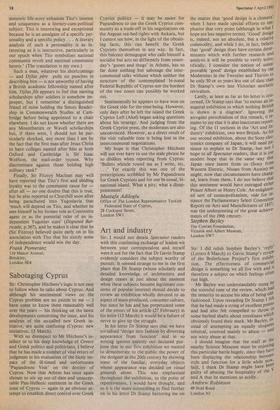Art and industry
Sir: I would not detain Spectator readers with this continuing exchange of leaden wit between your correspondent and myself were it not for the fact that Dr Gavin Stamp evidently considers the subject worthy of pursuit. It seemed strange to me in the first place that Dr Stamp (whose scholarly and detailed knowledge of architecture and design ceases at just about the moment when these subjects become legitimate con- cerns of popular interest) should decide to review an exhibition wholly devoted to an aspect of mass-produced, consumer culture, but since he has and has perpetuated some of the errors of his article (27 February) in his letter (13 March) it would be a failure of nerve to give up the struggle.
In his letter Dr Stamp says that we have trivialised 'design into fashion by divorcing appearance from function' and in so writing ignores entirely our declared pur- pose that in our first exhibition we wanted to demonstrate to the public the power of the designer in the 20th century by showing some of the familar, everyday objects whose appearance was decided on visual grounds alone. This was emphasised throughout the exhibition, to the point of repetitiveness, I would have thought, and so it is the more astonishing to find further on in his letter Dr Stamp hectoring Me on the matter that 'good design is a chimera' when I have made special efforts to em- phasise that very point (although in what I hope are less negative terms). 'Good' design is, indeed, not an absolute, but a relative commodity, and while I do, in fact, believe that 'good' design does have certain deter- minants which with further research and analysis it will be possible to verify scien- tifically, I consider the notion of unit-im- provable 'good' design established by the Modernists in the Twenties and Thirties to be only 30 or so years less out of date than Dr Stamp's own late Victorian aesthetic revivalism.
Lastly, at least as far as his letter is con- cerned, Dr Stamp says that 'to mount an in- augural exhibition in which nothing British is shown is a disgrace'. Ignoring the arrogant parochialism of this remark, it re- mains to say that it is also inaccurate report' ing. Of the 11 sections in the 'Art and 111' dustry' exhibition, two were British. As for our second exhibition, about the Sony elec- tronics company of Japan, it will need Pa- tience to explain to Dr Stamp, but not I hope to all Spectator readers, that it is our modest hope that in the same way that Japan once learnt from us (Sony from Western Electric, Nissan from Austin) we might, now that circumstances have chang- ed, learn from them. I do not believe that this sentiment would have outraged either Prince Albert or Henry Cole. An enlighten- ed sort of cosmopolitanism, vide for in- stance the Parliamentary Select Committee Report on Arts and Manufactures of 1831, was the underpinning of the great achieve- ments of the 19th century.
Stephen Bayley
The Conran Foundation, Victoria and Albert Museum, London SW7




































 Previous page
Previous page